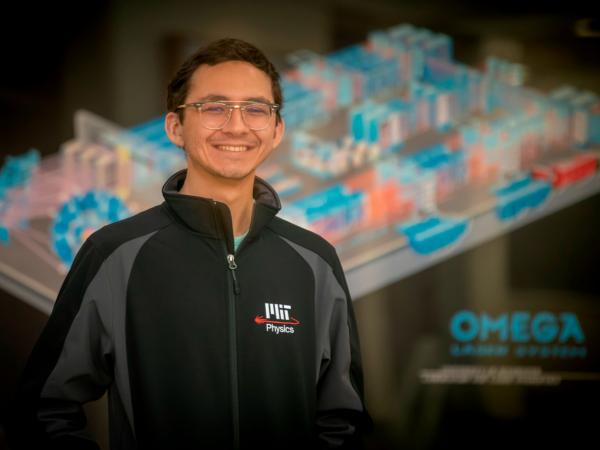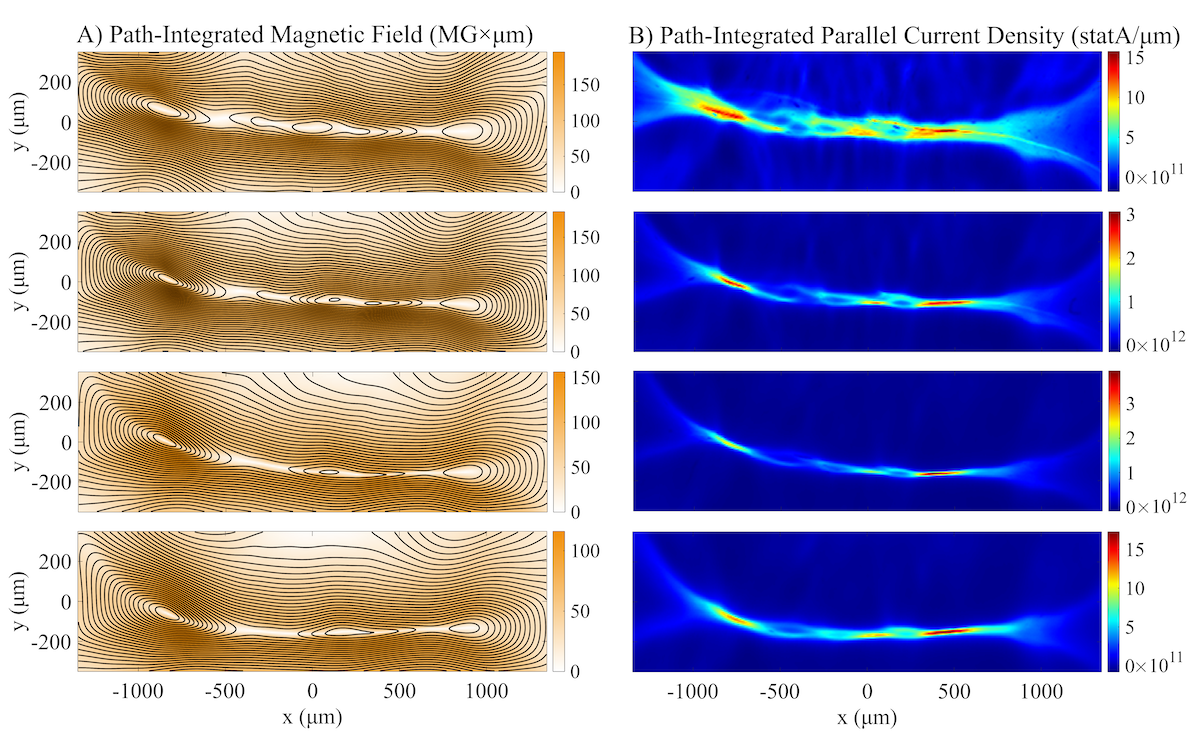
Jacob Pearcy used data from OMEGA, a powerful experimental laser housed at the University of Rochester's Laboratory for Laser Energetics.
PSFC graduate student Jacob Pearcy has used new analysis techniques on 12-year-old data from OMEGA laser experiments to document the formation of plasmoids and help explain the physics of magnetic reconnection.
May 3, 2024
Jacob Pearcy, a sixth-year PhD student at the Plasma Science and Fusion Center, and his co-authors from MIT and the University of Rochester have offered new insight into the nature of magnetic reconnection, a process that underpins astrophysical phenomena like solar flares, and that can also influence the behavior of fusing plasmas. In the paper, “Experimental evidence of plasmoids in high- β magnetic reconnection” recently published in Physical Review Letters, Pearcy combines older data with new analysis techniques to help explain the physics behind the release of magnetic energy in fusing plasmas.
As Pearcy explained it, magnetic reconnection in plasmas is “the way magnetic fields can rearrange themselves. In ideal plasma physics, magnetic fields aren’t supposed to be able to break and connect with other field lines, but in real-world non-ideal plasmas that’s not always true.”
That unexpected behavior can be observed on a macro scale in solar flares, a natural part of the sun’s cycle, which are a type of magnetic reconnection event. Put very simply, solar flares occur when the sun’s plasma becomes hyper-excited due to its magnetic field lines breaking apart and reconnecting. Lots of energy is released when the field lines reconnect, causing giant jets of electromagnetic radiation to arc out of the sun. Before we knew that magnetic fields could break apart, scientists attempted to build a theoretical framework to define the behavior of solar flares, their math predicted that the events would unfold over the course of weeks or months, when in reality they only took hours or days. Over many years, models (some of them controversial) have been developed that get closer to describing “fast” reconnection-- the models’ rates match events’ actual timescales--but it’s not a perfect fit, and the how of fast reconnection has remained mysterious.
Percy and his co-authors’ experiment provided some insight into fast reconnection by capturing the formation of plasmoids, which are self-contained “islands” of field lines that develop within the river of plasma that contains them. Plasmoids disrupt the field lines present in the plasma, causing them to reconnect faster and release lots of energy--enough to reconcile some of the inconsistencies seen in the models of fast reconnection.
The team reanalyzed data collected from experiments conducted at the University of Rochester with the OMEGA EP Laser in 2012. Although the data were several years old, advances in technologies used to visualize and reconstruct the events allowed Pearcy and his co-authors to definitively show the presence of a reconnection layer—the area where magnetic field islands are collapsing and rejoining adjacent field lines, firing off bits of energy in the process. “The ‘leap’ here was using the new analysis techniques for radiography on these data,” said Pearcy.

While plasmoids and reconnection layers had been observed in lab experiments before, this is the first time they have been seen in a setup with strong magnetic fields and very high pressure (a “high-beta environment”), which are the conditions created by the OMEGA laser and, importantly, in inertial confinement fusion (ICF). The fuel for ICF is contained in a tiny cylinder with special and sometimes mysterious properties known as a hohlraum. Firing powerful lasers at the hohlraum causes it to implode, causing magnetic reconnection and releasing energy; studying those reconnection events can help researchers better understand the field dynamics present in hohlraums. “In a way, the hohlraum is kind of like taking our experiment and wrapping it in a cylinder, so understanding the basic interaction of magnetic fields can help us understand the hohlraum better,” he explains. Unwrapping the mysteries of magnetic fields in hohlraums allows researchers to better exploit its properties and more efficiently generate ICF energy.
Pearcy was clear this research and paper wouldn’t have been possible without a supportive team at his back: “I’d like to thank my co-authors, Mike Rosenberg, Tim Johnson, Graeme Sutcliffe, Ben Reichelt, Jack Hare, Nuno Loureiro, Rich Petrasso, and Chikang Li, and the entire High Energy Density Physics group at the PSFC. They’ve been very supportive throughout this process and I’m really grateful for all their help.”